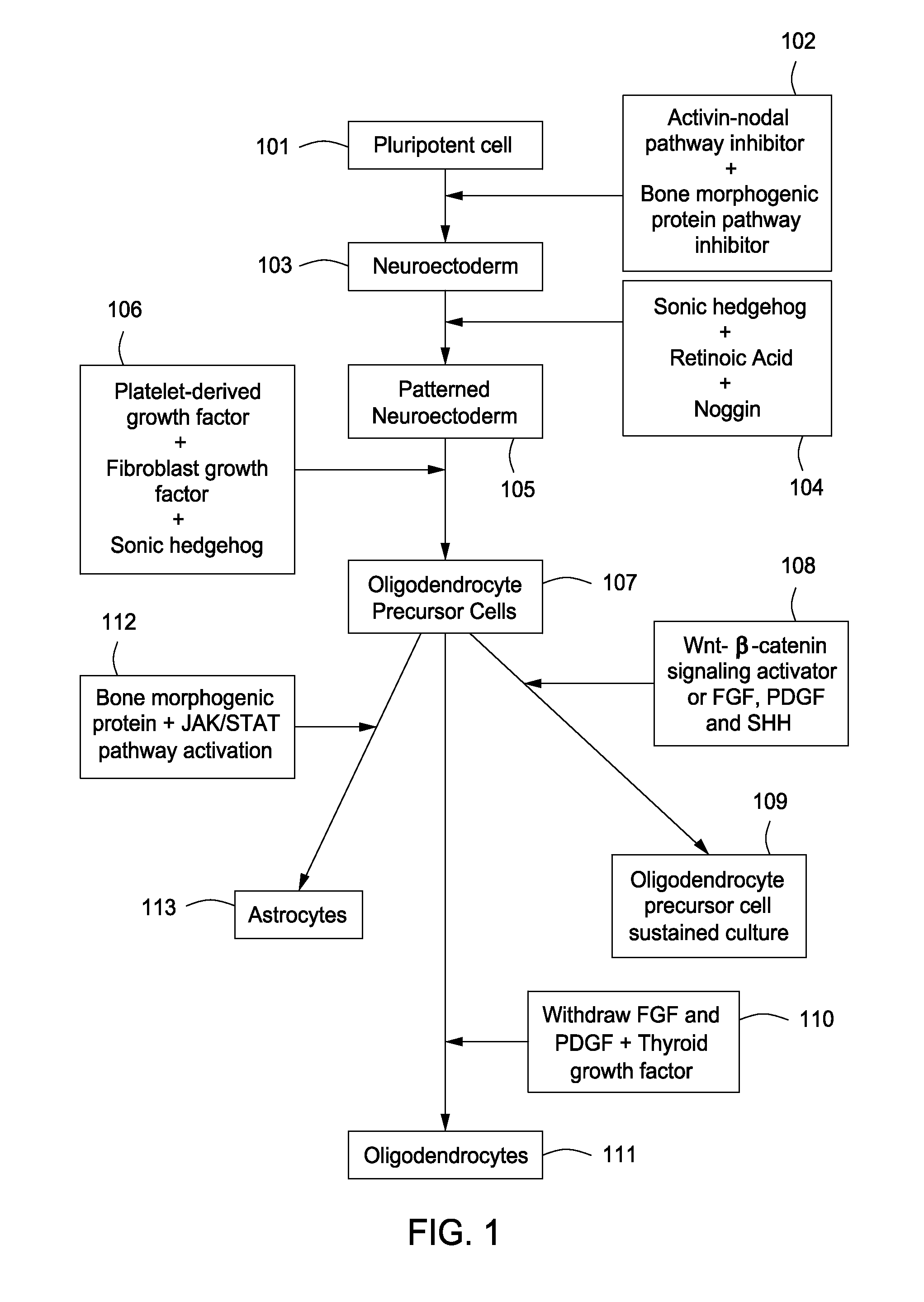Differentiation method for production of glial cell populations
a technology of glial cell populations and differentiation methods, which is applied in the direction of biocide, embryonic cells, drug compositions, etc., can solve the problems of requiring far less time for oligodendrocyte progenitor cells, oligodendrocytes, and astrocytes to be produced by the method
- Summary
- Abstract
- Description
- Claims
- Application Information
AI Technical Summary
Benefits of technology
Problems solved by technology
Method used
Image
Examples
example 1
Differentiation of Pluripotent Cells to Neuroectoderm
[0089]All cells were cultured at 37° C. and 5% CO2 unless otherwise noted. Individual EpiSC lines were isolated from mice of strains 129SvEv (EpiSC5 and EpiSC7 lines), (12901 line) and 129SvEv×ICR (EpiSC9 line), and maintained in vitro in EpiSC base medium supplemented with 10 ng ml−1 PGF2 (R&D Systems, Minneapolis, Minn., 233-FB). Differentiation of EpiSCs to patterned neuroectoderm was a 5-day procedure with complete medium changes every day.
[0090]EpiSC base medium consisted of Knockout DMEM (Invitrogen, Carlsbad, Calif.) supplemented with 20% Knockout Serum Replacement (KSR; Invitrogen, Carlsbad, Calif.), 2 mM Glutamax (Invitrogen, Carlsbad, Calif.), 1× nonessential amino acids (Invitrogen, Carlsbad, Calif.) and 0.1 mM 2-mercaptoethanol (Sigma-Aldrich, St. Louis, Mo.). Neural base medium consisted of DMEM / F12 (Invitrogen, Carlsbad, Calif.; 11320) supplemented with 1×N2 (R&D Systems, Minneapolis, Minn.), 1×B-27 without vitamin A...
example 2
Differentiation of EpiSC-Derived, Patterned Neuroectoderm to OPCs
[0091]Day-5 patterned neuroectodermal cells were released from the culture dish using 1.5 mg ml−1 collagenase IV (Invitrogen, Carlsbad, Calif.) and dissociated to a single cell suspension using TrypLE Select (Invitrogen, Carlsbad, Calif.). Cells were counted and plated at 4×104 cells cm−2 on Nunclon-Δ plates coated with 0.1 mg ml−1 poly(L-ornithine) (Sigma-Aldrich, St. Louis, Mo.) followed by 10 μg ml−1 laminin (Sigma; L2020). Cells were grown in OPC medium consisting of neural base medium supplemented with 20 ng ml−1 FGF2, 20 ng ml−1 PDGF-AA (R&D Systems, Minneapolis, Minn.) and 200 ng ml−1 SHH, and fed every other day for 5 days. At this point cultures consisted of a highly pure population of proliferating OPCs.
example 3
OPC Culture
[0092]Cultures of EpiSC-derived OPCs were maintained and expanded in neural base medium supplemented with 20 ng ml−1 FGF2, 20 ng ml−1 PDGF-AA and 200 ng ml−1 SHH or 20 ng ml−1 PDGF-AA, 200 ng ml−1 SHH, 100 ng ml−1 noggin, 10 μM dibutyryl cyclic-AMP sodium salt (Sigma-Aldrich, St. Louis, Mo.), 100 ng ml−1 IGF-1 (R&D Systems, Minneapolis, Minn.), and 10 ng ml−1 NT3 (R&D Systems, Minneapolis, Minn.) and fed every other day. OPCs were grown on Nunclon-Δ plates coated with poly(L-ornithine) and laminin Cells were passaged every 3-5 days with TrypLE Select and typically seeded at 2×104 cells cm−2. OPCs could be readily frozen or thawed and were cryopreserved in DMEM supplemented with 10% FBS (Invitrogen, Carlsbad, Calif.) and 10% DMSO (Sigma-Aldrich, St. Louis, Mo.). For the cumulative OPC experiment, at ‘passage 0’ 4×104 cells cm−2 were seeded. Subsequently, cells were passaged at 80-90% confluence and seeded at 2×104 cells cm−2. Total cell number at each passage was counted w...
PUM
| Property | Measurement | Unit |
|---|---|---|
| pH | aaaaa | aaaaa |
| temperature | aaaaa | aaaaa |
| temperature | aaaaa | aaaaa |
Abstract
Description
Claims
Application Information
 Login to View More
Login to View More - R&D
- Intellectual Property
- Life Sciences
- Materials
- Tech Scout
- Unparalleled Data Quality
- Higher Quality Content
- 60% Fewer Hallucinations
Browse by: Latest US Patents, China's latest patents, Technical Efficacy Thesaurus, Application Domain, Technology Topic, Popular Technical Reports.
© 2025 PatSnap. All rights reserved.Legal|Privacy policy|Modern Slavery Act Transparency Statement|Sitemap|About US| Contact US: help@patsnap.com



